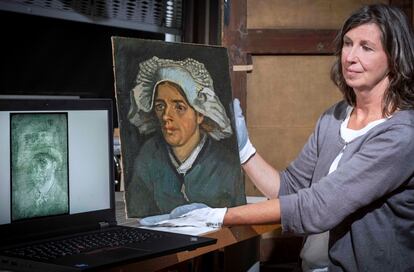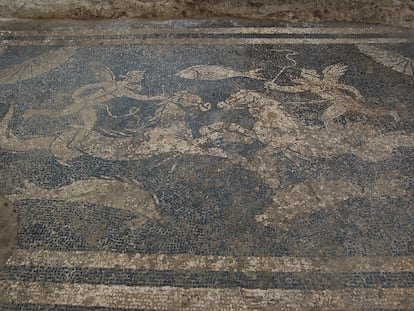Vincent van Gogh self-portrait found hidden on back of painting
The work was discovered on the reverse side of the canvas for ‘Head of a Peasant Woman’ and only came to light after researchers X-rayed the picture


Vincent van Gogh painted with frenzy and on any material he could get his hands on. When he ran out of money to buy canvas, or while waiting for materials from his brother, Theo, to arrive, he painted on tablecloths and tea towels. He also made use of paintings he had already completed. And that is exactly where a previously unknown self-portrait of the artist has been discovered: on the back of his work Head of a Peasant Woman (1885). The front of the canvas features an oil painting of a young woman, and the back is a self-portrait Van Gogh painted two years later. The image was covered under a thick layer of glue and cardboard, and was only discovered thanks to an X-ray examination by experts from the National Galleries of Scotland, which has had the painting in its collection since 1960.
The discovery occurred by chance, while the painting was being researched for an exhibition called A Taste for Impressionism, which will now feature the X-ray images of the self-portrait alongside Head of a Peasant Woman. Once the exhibition ends, the museum’s restorers will try to recover the self-portrait. Frances Fowle, a senior curator, told the British press that this process must be done carefully and slowly.
Louis van Tilborgh, a Van Gogh specialist in Amsterdam, has no doubts about the authenticity of the self-portrait. As a veteran researcher and specialist in the work of his compatriot, he points out on the phone that “it fits into a kind of series, because Van Gogh has at least eight paintings in which he painted himself on the reverse side of the canvas.” According to Van Tilborgh, the artist prepared the canvases, “so that he could paint from behind, which gives them added value, artistic and emotional value of course. Paintings like this one, found in Scotland, belong to public collections, so it’s not for me to talk about monetary value.”
Experts at the National Galleries of Scotland estimate that the layers of glue and cardboard were put on the painting around 1905. At this time, the work was being prepared for an exhibition at the Stedelijk Museum, in Amsterdam, and the face of the peasant must have been considered more interesting – and complete – than the self-portrait, which appears unfinished. According to data provided by the National Galleries of Scotland, Head of a Peasant Woman was acquired in 1923 by Evelyn Saint Croix Fleming, the mother of James Bond creator Ian Flemming, and came to the gallery in 1960.
The young model for Van Gogh’s painting could have been Gordina de Groot, nicknamed Sien, who appears among the diners in the painting The Potato Eaters, also from 1885. In 1887, the date attributed to hidden self-portrait, Van Gogh had come into contact with the work of impressionists such as Émile Bernard and Paul Gauguin. His style and use of color changed thereafter, and light flooded his work.
Van Gogh’s devotion to art endowed his works with a particular intensity. A devotion that, together with his mental and health problems, eventually led him to the Saint-Rémy de Provence asylum, in southeastern France. He admitted himself into the mental health facility in 1889, after cutting off his ear in an episode of psychosis. Despite his mental health problems, Van Gogh painted many works while at the asylum. Just one year later, however, he moved to Auvers-sur-Oise, a town near Paris, where he is believed to have shot himself in the chest.
Tu suscripción se está usando en otro dispositivo
¿Quieres añadir otro usuario a tu suscripción?
Si continúas leyendo en este dispositivo, no se podrá leer en el otro.
FlechaTu suscripción se está usando en otro dispositivo y solo puedes acceder a EL PAÍS desde un dispositivo a la vez.
Si quieres compartir tu cuenta, cambia tu suscripción a la modalidad Premium, así podrás añadir otro usuario. Cada uno accederá con su propia cuenta de email, lo que os permitirá personalizar vuestra experiencia en EL PAÍS.
¿Tienes una suscripción de empresa? Accede aquí para contratar más cuentas.
En el caso de no saber quién está usando tu cuenta, te recomendamos cambiar tu contraseña aquí.
Si decides continuar compartiendo tu cuenta, este mensaje se mostrará en tu dispositivo y en el de la otra persona que está usando tu cuenta de forma indefinida, afectando a tu experiencia de lectura. Puedes consultar aquí los términos y condiciones de la suscripción digital.
More information
Últimas noticias
Most viewed
- Sinaloa Cartel war is taking its toll on Los Chapitos
- Reinhard Genzel, Nobel laureate in physics: ‘One-minute videos will never give you the truth’
- Oona Chaplin: ‘I told James Cameron that I was living in a treehouse and starting a permaculture project with a friend’
- Why the price of coffee has skyrocketed: from Brazilian plantations to specialty coffee houses
- David King, chemist: ‘There are scientists studying how to cool the planet; nobody should stop these experiments from happening’










































